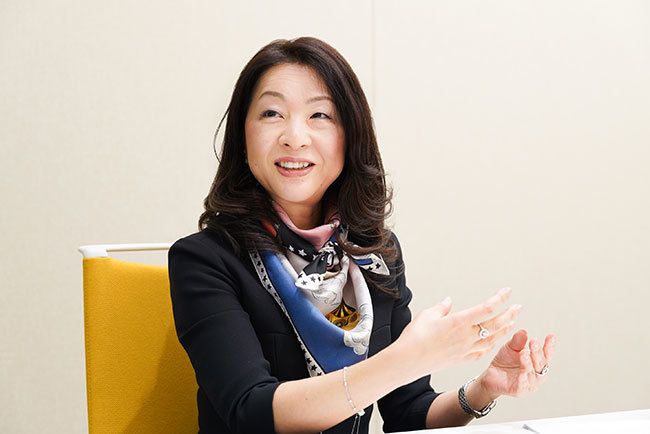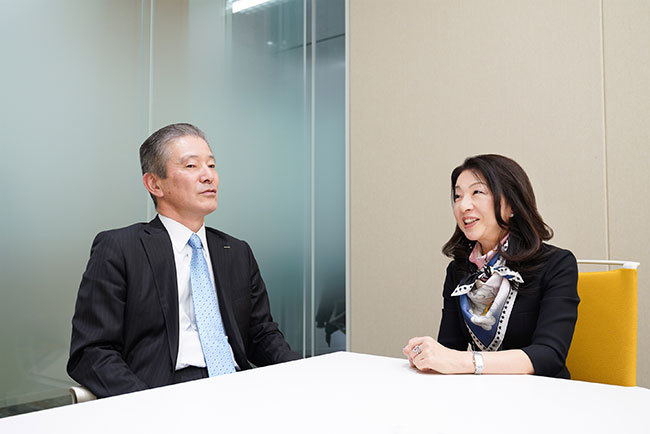" Japan's Advertising Expenditures in 2017 " exceeded the previous year's figures for the sixth consecutive year. Internet advertising expenditures, achieving double-digit growth for the fourth consecutive year, are driving the overall market.
Mr. Ritsuya Oku of Dentsu Inc. Media Innovation Lab interviewed Professor Nobuko Kawashima of Doshisha University, an expert in cultural economics and content industry theory who also serves as a specialist committee member for the Ministry of Internal Affairs and Communications' Information and Communications Council, about notable points for each media type and young people's media consumption habits.

Professor Nobuko Kawashima of Doshisha University (right) and Ritsuya Oku of Dentsu Inc. Media Innovation Lab
Internet Becomes Advertising Mainstream
Oku: Japan's total advertising expenditure in 2017 reached 6.3907 trillion yen, a 101.6% increase from the previous year, marking six consecutive years of positive growth. Internet advertising expenditure, in particular, achieved double-digit growth for the fourth consecutive year, surpassing 1.5 trillion yen for the first time and continuing to lead the overall growth in advertising spending. What are your thoughts on this result?
Kawashima: While internet advertising spending surpassing ¥1 trillion in 2014 was a major talking point, in a sense, I feel this result is even more impactful than that milestone. In the UK and US, internet advertising spending has already surpassed television advertising spending. Globally, it's predicted that online advertising spending will exceed television spending by 2018. The reality is that significant growth in television advertising spending is not highly anticipated, whereas internet advertising spending still has considerable room for growth. I believe these figures reflect that reality.
Oku: The ratio of total advertising expenditure to Japan's nominal GDP has generally hovered just over 1%. Simply put, the structure is such that advertising expenditure increases as the economy grows. However, Japan's GDP has barely grown over the past 15 years. With gross advertising expenditure stagnant, internet advertising expenditure has grown, naturally leaving television advertising expenditure largely flat or fluctuating within a narrow range.
However, demand for TV advertising persists. Compared to Japan, the economies of the UK and US are performing well. While internet advertising is growing there, TV advertising is also growing. Even among these three developed nations, the overall macro view of advertising expenditure feels quite different. Advertising expenditure trends are intrinsically linked to a nation's economic strength. While innovation is often cited as the key to Japan's economic growth, the focus now is on whether its economic and social systems can transform into new forms.
Are SNS ads more effective than TV ads!?
Oku: Professor Kawashima, you have frequent contact with students. How do you view the relationship between young people and media?
Kawashima: When I ask university students, "Have you been watching any dramas lately?", I get absolutely no response. Since it's a cultural economics seminar, you'd expect them to have at least some interest in TV and content, but they aren't watching. Yet, they're incredibly knowledgeable about comedians, saying things like "I saw it on Twitter" or "I watched it on YouTube." It's not that they dislike TV, but they don't express any active interest.
Probably because they can't watch it whenever and however they want, right at their fingertips. For them, television is an inconvenient medium. With smartphones, they can focus on viewing their friends' photos, tweets, YouTube videos—anytime, anywhere.
Oku: Today's college students were around fourth grade when the iPhone debuted, making them true smartphone natives. They're likely exposed to far more information shared on social media than traditional mass media. How do students interact with advertising?
Kawashima: Observing them, I sense they believe ads on social media reach more people than TV commercials. They think social media has greater ripple and persuasive effects because it spreads.
Traditionally, TV was seen as the medium for mass appeal, but young people seem to feel the opposite. They believe the information they want is online, and that in-depth information not covered by mass media is found on social media. Clicking on an ad that flows from the internet gives them detailed information about products or services instantly. Meanwhile, TV is increasingly positioned as not being a medium for deep understanding.
Television's Challenge to the Internet
Kawashima: I think it was over a decade ago, but in a survey asking Americans what they wanted from television, the top response was "I want to use the internet on my TV." At the time, I didn't quite grasp the meaning and thought maybe they wanted to display search results on a big screen. But essentially, they wanted to watch online videos like YouTube the same way they watch TV programs. That's now becoming a reality in Japan too.
Oku: According to Dentsu Inc. research, the TV screen connection rate in Japan has reached 29%. More people are connecting their TVs to the internet and watching YouTube, Netflix, DAZN, and other services on their big screens.
I call it "back to TV." We've progressed from PCs to feature phones, smartphones, and tablets. When consuming entertainment content online, if you're at home, you naturally want to watch it on a big screen, right? Research shows many people watch YouTube music videos. In other words, TVs are replacing the old stereo. Recently, more homes lack a stereo in the living room, and often the TV offers the best sound in the house.People do various things while music plays on the TV. The TV has become the gateway for dual or even triple multitasking.
Of course, many people also watch Netflix or Hulu, and weekend binge-watching is incredibly popular. Considering these viewing patterns and how TV is used, I think broadcasters need to push more content online and adopt a mindset like Radiko's.
Kawashima: Japanese TV stations excel at creating entertainment content. They can use that as a foundation to gather viewers, get them to register attributes and other information, and reliably capture their entertainment and leisure activity histories. That data can also be leveraged for e-commerce. To put it bluntly, wouldn't it be fine if TV stations became like Amazon?
Oku: Given current momentum, Amazon—which deeply understands customer purchasing behavior through its e-commerce expansion—might become a TV broadcaster faster. They've already launched video services under Amazon Prime, right?
Take Radiko's Share Radio or AbemaTV, for example—users can share their favorite programs on social media. When spread via hashtags, the network effect becomes massive: anyone who sees the hashtag can click it and watch the program. If TV can build such mechanisms, it still has a bright future. I believe there are still many ways to get people to watch content online.
Moving freely between real and digital
Kawashima: It's interesting to see the increase in advertising costs for "exhibitions, videos, and other media" this time. The crowd-drawing power of events utilizing digital technology, like projection mapping, is incredible. Why are people so captivated by these things? The more digitization advances, the more I feel the value of analog experiences—like actually going to the venue or sharing the moment with many people in person—is rising.
Young people won't pay for content they can get online. But just look at how much money they spend on anime song concerts! Ticket fees, travel and lodging expenses under the guise of "expeditions," buying mountains of related merchandise, and generously sharing it with friends. They spend astonishing amounts (laughs).
Oku: Projection mapping is a digital expression, yet it provides a real experience that stimulates the human senses. I think there's a communication loop combining analog and digital elements: "real-life content," "Instagram-worthy moments," and "sharing to get excited together."
Kawashima: I believe 2014 was the year the live concert market surpassed the music software market (like CDs) in sales. The value of the on-site experience and its uniqueness has relatively increased. This is a very interesting phenomenon.
Oku: Young people are drawn to "only now" and "only here." Meanwhile, they demand "anytime" and "anywhere" from media. You could call user needs selfish (laughs). At the very least, I wish they understood that information always carries a cost somewhere.
Kawashima: Comparing the 50 years from 1950 to 2000 with the last decade, it's said the changes in this decade have been far greater. That applies to media, advertising methods, and marketing, right?
Oku: Just looking at smartphones, they've changed dramatically in the last decade. Children born from now on will grow up in a 5G world, so they'll experience information at a completely different speed.
Kawashima: Even so, exam answers are still handwritten, so students are good at handwriting (laughs). It's a world of pencils and erasers, so that part is super analog. In classrooms, no one takes notes on a computer, but they do take pictures of the blackboard with their smartphones. But adults do the same thing. When you watch presentations, you hear "click-clack" sounds coming from all around.
Young people are often said to casually consume information across triple screens, but adults over 40 should recognize this too. Even if not triple screens, most definitely use at least two. More people only engage with news, documentaries, dramas, or entertainment to that extent. In that sense, adults and young people aren't actually that different.
Oku: Rather than rigidly categorizing adults as analog and youth as digital, perhaps what's needed are devices and media that allow us to freely switch between analog and digital depending on the time, place, occasion, and motivation. Thank you for today.













